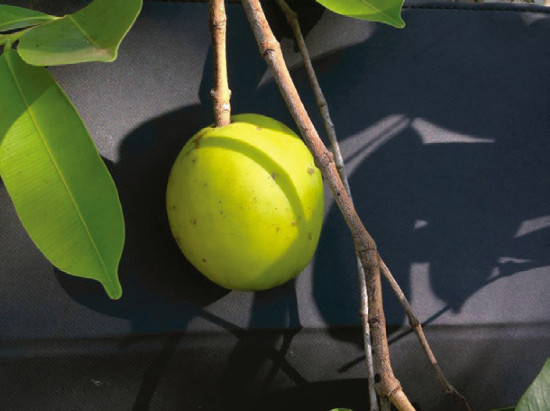Recubrimiento comestible en la conservación poscosecha del mangaba endémico

Resumen
El Cerrado brasileño es uno de los mayores biomas del mundo y considerado el más rico. La fruta mangaba es representativa de este bioma pero es altamente perecedera. El objetivo de este estudio fue evaluar la aplicación de recubrimientos comestibles en la poscosecha de mangaba. Se utilizaron frutas con buen aspecto y ausencia de lesiones. El experimento se realizó en esquema factorial (3 tratamientos × 6 períodos de almacenamiento). Después de la desinfección y secado, las mangabas recibieron los siguientes tratamientos: (1) recubrimiento de proteína de suero; (2) recubrimiento de almidón de maíz; (3) sin revestimiento (control). Las bandejas con los frutos se almacenaron a temperatura ambiente (25°C). Se evaluaron los niveles de pérdida de masa, pH, sólidos solubles totales (SST), acidez total titulable (ATT), firmeza y ácido ascórbico en periodos de almacenamiento de 0, 2, 4, 6, 8 y 10 días. Los datos fueron evaluados mediante análisis de varianza, prueba de Tukey y regresión. El revestimiento comestible con proteína de suero obtenido resultados satisfactorios en la conservación de mangaba, mostró buenos resultados para la relación SST/ATT (16) y vitamina C (116 mg/100 g). Los recubrimientos influyeron en la vida útil y en las características pos cosecha de estas frutas, pero el recubrimiento con proteína de suero de leche es el más indicado para la mangaba.Palabras clave
Cubierta, Harconia scpeciosa var. gardineri, cerrado, vida útil.
Citas
- Adámoli, J., J. Macedo, L.G. Azevedo, and J.M Neto. 1978. Caracterização da região dos Cerrados. pp. 33-98. In: Giedert, W.J. (ed.) Solos do Cerrado: Tecnologias e estratégias de manejo. CPAC, Planaltina-DF, Brazil.
- Aguiar, S., I.S. Santos, N. Arêdes, and S. Silva. 2016. Redes-Bioma: Informação e Comunicação para ação sociopolítica em ecorregiões. Ambient. Soc. 19, 231-248. Doi: https://doi.org/10.1590/1809-4422ASOC20140004V1932016
- Alleoni, A.C.C., A.P. Jacomino, and A.S. Rosa. 2006. Recobrimento de Laranja “Pêra” com filme de concentrado proteico de soro de leite associado a plastificantes. Pesq. Agropecu. Bras. 41, 1221-1226. Doi: https://doi.org/10.1590/S0100-204X2006000800002
- Antunes, L.E.C., E.D. Gonçalves, and R. 2006. Trevisan. Alterações de compostos fenólicos e pectina em pós-colheita de frutos de Amora-Preta. Rev. Bras. Agrociênc. 12, 57-61.
- AOAC (Association Official Analytical Chemistis). 2010. Official methods of analysis of AOAC International. 18th ed. Gaithersburg, MD, USA.
- Assis, O.B.G. and D. Brito. 2014. Revisão: coberturas comestíveis protetoras em frutas: fundamentos e aplicações. Bras. J. Food Technol. 17, 87-97. Doi: https://doi.org/10.1590/bjft.2014.019
- Campos, R.P., B. Knoch, P.A. Hiane, M.I.L. Ramos, and M.M. Ramos Filho. 2011. 1-MCP em Mangabas armazenadas em temperatura ambiente e a 11ºC. Rev. Bras. Frutic. 33, 206-212. Doi: https://doi.org/10.1590/S0100-29452011000500024
- Calbo, A.G. and A.A. Nery. 1995. Medida de firmeza em hortaliças pela técnica de aplanação. Hortic. Bras. 3, 14-18.
- Carnelossi, M.A.G., W.F.F. Toledo, D.C.L. Souza, M.L. Lira, G.F.J. Silva, R. Vahideh Rabani, and P.R.A. Viégas. 2004. Conservação pós-colheita de mangaba (Hancornia speciosa Gomes). Ciênc. Agrotecnol. 28, 1119-1125. Doi: https://doi.org/10.1590/S1413-70542004000500021
- Chitarra, M.I.F. and A.B. Chitarra. 2005. Pós-colheita de frutas e hortaliças: fisiologia e manuseio. 2nd ed. UFLA, Lavras-MG, Brazil.
- Embrapa. 2007. Sistema de produção da mangaba para os tabuleiros costeiros e baixadas litorâneas. In: http://sistemasdeproducao.cnptia.embrapa.br/FontesHTML/Mangaba/SistemaProducaoMangabaTabuleirosCosteiros/Introducao.html; consulted: February, 2017.
- Fakhouri, F.M. and C. Grosso. 2003. Efeito de Coberturas Comestíveis na vida útil de goiabas in natura (Psidium guajava L.) mantidas sob refrigeração. Bras. J. Food Technol. 6, 203-211.
- Farias, J.F., S.E. Araújo Neto, V.S. Álvares, P.A. Ferraz, D.T. Furtado, and M.L. Souza. 2011. Maturação e determinação do ponto de colheita de frutos de envira-caju. Rev. Bras. Frutic. 33, 730-736. Doi: https://doi.org/10.1590/S0100-29452011005000100
- FDA (Food and Drug Administration). 2013. Generally recognized as safe (GRAS). In: http://www.fda.gov/Food/IngredientsPackagingLabeling/GRAS/; consulted: March, 2017.
- Gago, M.B.P., S.M. Serra, and M.A.D. Rio. 2006. Color change of fresh-cut apples coated with whey protein concentrate-based edible coatings. Postharvest Biol. Technol. 39, 84-92. Doi: https://doi.org/10.1016/j.postharvbio.2005.08.002
- Lee, S.K. and A.A. Kader. 2000. Preharvest and postharvest factors influencing vitamin C content of horticultural crops. Postharvest Biol. Tecnol. 20, 207-220.
- Nasser, F.A.C.M., A.C. Boliani, M.F. Nasser, and M.K. Pagliarini. 2016. Conservação de mangabas submetidas à aplicação de quitosana. Rev Cientif. 44, 279-295. Doi: https://doi.org/10.15361/1984-5529.2016v44n3p279-285
- Strohecker, R. and H.M. Henning. 1976. Análises de vitaminas: métodos comprovados. Ed. Paz Montalvo, Madrid, Spain.
- Vicentino, S.L., P.A. Floriano, and D.C. Dragunski. 2011. Filmes de amido de mandioca modificados para recobrimento e conservação de uvas. Quim. Nova 34, 1309-1314, 2011. Doi: https://doi.org/10.1590/S0100-40422011000800003
- Vieira, R.F., T.S. Agostini-Costa, D.B. Silva, S.M. Sano, and F.R. Ferreira. 2010. Frutas nativas da região Centro-Oeste do Brasil. Embrapa Informação Tecnológica, Brasília, Brazil. pp. 188-213.
Descargas
Los datos de descargas todavía no están disponibles.
